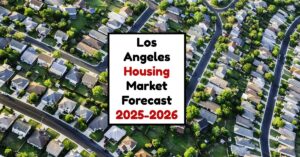Are you curious about the current Los Angeles housing market trends? Well, the short answer is that the LA housing market is showing signs of a slow but steady recovery. While it's not exploding with growth, we're seeing a bit more activity compared to last year, with home sales showing a slight uptick and home prices experiencing modest gains. The market is cautiously optimistic, with experts predicting continued improvement through the second and third quarters of 2025.
But, of course, it's never that simple. Let's dig a little deeper and really get into the details of what's shaping the real estate scene here in the City of Angels.
Current Los Angeles Housing Market Trends:
Home Sales
Looking at the most recent data, home sales in Los Angeles County have seen some movement. According to the California Association of REALTORS® (C.A.R.), in February 2025, the Los Angeles Metro Area saw a 9% increase in sales month-over-month. However, year-over-year, sales decreased by 2.5%. While this might seem like a mixed bag, it suggests that while activity is picking up compared to the start of the year, we're still slightly below where we were this time last year.
- February 2025 (Month-over-Month): Sales up 9.0%
- February 2025 (Year-over-Year): Sales down 2.5%
This can mean a few things. Maybe buyers are feeling more confident now that mortgage rates have stabilized a bit. Or perhaps more sellers are putting their homes on the market, giving buyers more choices. It is worth watching whether the current trend will continue or whether a slowdown lies ahead,
Home Prices
Now, let's talk money! What's happening with home prices? As you might expect, this is the million-dollar question (or, in LA, maybe the multi-million dollar question!).
The median sales price of an existing single-family home in Los Angeles County in February 2025 was $852,190, down 3.9% month-over-month but up 4.3% year-over-year, This shows that despite monthly fluctuations, there is still an overall upward trend in prices when we compare February 2025 to February 2024.
- February 2025 (Month-over-Month): Prices down 3.9%
- February 2025 (Year-over-Year): Prices up 4.3%
Are Home Prices Dropping?
This is where things get interesting. While the data shows a monthly drop in median home prices in Los Angeles County, it's crucial to consider this in context. Real estate is seasonal, and we often see dips during certain times of the year. Also, median prices can be influenced by the type of homes being sold (more high-end homes selling can skew the median upward, and vice versa).
Based on the data from C.A.R., the general trend is still towards increasing prices year-over-year. The monthly dip could just be a temporary blip before prices start climbing again as we head into the spring and summer months, which are usually busier buying seasons.
Comparison with Current National Median Price
How does Los Angeles stack up against the rest of the country? As of February 2025, the national median home price is $398,400. Los Angeles County, with a median price of $852,190, is significantly higher. That's more than double the national median! This highlights just how competitive and expensive the Los Angeles housing market remains compared to many other areas in the U.S. The year-over-year change nationally is +3.8%, which is very similar to the 4.3% year-over-year increase in Los Angeles, suggesting that the market is growing at par with the national average.
Housing Supply
The number of homes available for sale, also known as housing supply, plays a big role in determining whether it's a buyer's or seller's market. When there are lots of homes on the market, buyers have more negotiating power. When inventory is low, sellers can command higher prices.
According to C.A.R., the Unsold Inventory Index (UII) for Los Angeles County in February 2025 was 4.1 months. This is an increase from 3.1 months in February 2024. The UII represents the number of months it would take to sell all the homes currently on the market at the current sales rate.
- February 2025 UII: 4.1 months
- February 2024 UII: 3.1 months
What does this tell us? The increase in UII suggests that there are more homes available for sale now compared to last year. This is good news for buyers, as it means more choices and potentially less competition.
Is It a Buyer's or Seller's Housing Market?
So, who has the upper hand right now? Is it a buyer's or seller's housing market in Los Angeles?
Generally, a UII of less than 4 months indicates a seller's market, while a UII of more than 6 months suggests a buyer's market. With a UII of 4.1 months, Los Angeles is hovering right around the line. It leans towards a balanced market, but still has some elements of a seller's market. This means that while buyers have more options than they did last year, it's still not a complete free-for-all. Good properties in desirable locations are still likely to attract attention and multiple offers.
Market Trends
Okay, let's step back and look at the bigger picture. What are some of the key market trends shaping the Los Angeles housing market right now?
- Increased Inventory: As we've already discussed, there are more homes for sale than there were a year ago. This gives buyers more choices and can ease some of the pressure in bidding wars.
- Slightly Slower Sales Pace: While sales are up month-over-month, they are still slightly down year-over-year. This suggests that buyers are being more cautious and taking their time to find the right property.
- Stabilizing Mortgage Rates: After a period of significant volatility, mortgage rates seem to be settling into a more stable range. This can help buyers feel more confident about making a purchase.
- Continued Affordability Challenges: Despite some positive signs, Los Angeles remains one of the most expensive housing markets in the country. Affordability is still a major hurdle for many potential buyers.
Impact of High Mortgage Rates
Speaking of mortgage rates, these play a HUGE role in the housing market. Higher rates mean higher monthly payments, which can make it harder for people to afford a home.
Currently, in March 2025, the average 30-year fixed mortgage rate is around 6.67%, and the 15-year fixed-rate mortgage (FRM) is about 5.83%, according to Freddie Mac. Most forecasts predict that these rates will remain at or slightly above this level for the near future.
Here's a quick look at how those rates translate into monthly payments (excluding property taxes and insurance):
| Loan Type | Interest Rate | Loan Amount | Estimated Monthly Payment |
|---|---|---|---|
| 30-Year Fixed | 6.67% | $600,000 | $3,867 |
| 15-Year Fixed | 5.83% | $600,000 | $4,968 |
As you can see, even a small difference in interest rates can significantly impact your monthly budget. This is why it's so important to shop around for the best rates and to factor mortgage costs into your overall affordability calculations. The high mortgage rate environment has pushed many potential buyers into a ‘wait and see' mode as they strategize their next course of action.
Table: Key Housing Market Indicators (Los Angeles County)
| Indicator | February 2025 | January 2025 | February 2024 |
|---|---|---|---|
| Median Sales Price | $852,190 | $886,400 | $817,100 |
| Month-over-Month Price Change | -3.9% | N/A | N/A |
| Year-over-Year Price Change | 4.3% | N/A | N/A |
| Unsold Inventory Index (UII) | 4.1 months | 4.0 months | 3.1 months |
| Days on Market | 30 days | 33 days | 21 days |
What Does This All Mean for You?
So, if you're thinking about buying or selling in Los Angeles, what should you do?
- If you're a buyer: Take advantage of the increased inventory and shop around. Get pre-approved for a mortgage so you know what you can afford. Don't be afraid to negotiate, but be prepared to move quickly if you find a property you love.
- If you're a seller: Price your home competitively and make sure it's in top condition. Work with an experienced real estate agent who knows the local market. Be prepared to be patient, as homes may take a little longer to sell than they did a year ago.
My Take on the Los Angeles Housing Market
As someone who's been watching the Los Angeles real estate market for years, I think we're in a period of transition. The market is cooling off a bit from the frenzy of the past few years, but it's still a desirable place to live. The fundamentals of the LA market – strong job growth, a diverse economy, and a great lifestyle – are still in place. I expect to see continued moderate growth in the coming months, with prices gradually increasing as we move further into the year.
Los Angeles Housing Market Forecast: What to Expect in 2025 and Beyond
Thinking about buying or selling in the City of Angels? You're probably wondering what the future holds for the Los Angeles housing market. Here's the bottom line: While a dramatic crash isn't anticipated, expect moderate fluctuations. Zillow's latest forecast predicts a slight dip in the short term, followed by a modest increase over the next year. So, let's dive deeper into the specifics of the Los Angeles housing market forecast and what it means for you.
Currently, the average home value in the Los Angeles-Long Beach-Anaheim area is $971,996, showing a 4.4% increase over the past year. Homes are going pending in around 24 days, indicating a still-competitive market, though perhaps not as frenzied as we've seen in recent years.
A Closer Look at Zillow's Forecast: 2025-2026
To get a more granular view, let's break down Zillow's latest MSA (Metropolitan Statistical Area) forecast, focusing on Los Angeles. Remember that these are predictions, and the housing market can be influenced by many factors, but they provide a reasonable basis for our expectations.
| Region Name | Base Date | March 2025 Change | May 2025 Change | 1-Year Forecast (Feb 2025 – Feb 2026) |
|---|---|---|---|---|
| Los Angeles, CA | Feb 28, 2025 | -0.2% | -0.1% | 0.4% |
- March 2025: The forecast suggests a slight decrease of 0.2% in home values. This could be due to seasonal factors or a slight cooling of demand.
- May 2025: Another minor dip is anticipated, with a decrease of 0.1%. These short-term fluctuations are normal and shouldn't necessarily be a cause for alarm.
- February 2026 (1-Year Forecast): The overall prediction for the year is a modest increase of 0.4%. This indicates a generally stable market with slow but steady growth.
How Does Los Angeles Stack Up Against Other California Markets?
It's helpful to see how the Los Angeles forecast compares to other major metropolitan areas in California. Here’s a quick look:
| Region Name | March 2025 Change | May 2025 Change | 1-Year Forecast (Feb 2025 – Feb 2026) |
|---|---|---|---|
| San Francisco | 0% | 0.1% | -2.1% |
| Riverside | 0% | 0.5% | 1.7% |
| San Diego | -0.1% | 0.2% | 1.7% |
| Sacramento | -0.1% | 0.1% | -0.7% |
| San Jose | -0.8% | -2.7% | -2.9% |
| Fresno | 0.1% | 0.5% | 1% |
| Bakersfield | 0.2% | 0.9% | 2.3% |
As you can see, the Los Angeles housing market forecast is relatively moderate compared to some other areas. San Jose and San Francisco, for example, are predicted to see more significant declines over the next year. Riverside, San Diego, Fresno and Bakersfield are expected to outperform Los Angeles, and grow faster.
Will Home Prices Drop Significantly in Los Angeles? Could a Housing Crash Happen?
Based on current data and expert analyses, a major housing crash in Los Angeles seems unlikely. While prices might experience slight dips, the overall trend points towards continued stability and moderate growth. Several factors support this:
- High Demand: Los Angeles remains a desirable place to live, with strong demand driven by job opportunities, cultural attractions, and a desirable climate.
- Limited Inventory: The supply of homes in Los Angeles is still relatively constrained, which helps to support prices.
- Solid Economy: Despite some economic uncertainties, the Los Angeles economy is generally robust, with key sectors like entertainment, technology, and tourism driving growth.
Of course, unforeseen events could always impact the market. Interest rate changes, economic downturns, or major policy shifts could all influence home prices. However, at this point, a catastrophic drop seems improbable.
My Thoughts on the 2026 Outlook
Looking ahead to 2026, it's difficult to provide a definitive forecast without concrete data. However, if the trends observed in the current forecasts continue, I anticipate the Los Angeles housing market will likely see moderate, single-digit growth. Factors like interest rates and overall economic conditions will play a crucial role. If interest rates remain stable or decrease slightly, we could see a more robust increase in home values. Conversely, a significant economic slowdown could dampen growth.
Should You Invest in the Los Angeles Real Estate Market in 2025?
Los Angeles has historically been a sought-after real estate market due to its desirable location, diverse economy, and strong demand for housing. Here are some key points to consider:
Market Stability
Los Angeles has a relatively stable real estate market with a history of consistent, long-term appreciation in property values. This stability is driven by factors such as the city's status as an economic hub, its thriving job market, and the limited supply of land for new construction. However, it's essential to note that like any market, there can be fluctuations, and past performance is not indicative of future results.
Property Appreciation
Over the long term, Los Angeles properties have typically appreciated in value. While there can be short-term fluctuations, investing with a long-term perspective can allow you to benefit from the city's overall property value growth.
Rental Income Potential
Los Angeles has a strong rental market, with a high demand for both single-family and multi-family rentals. This presents an opportunity for investors to generate rental income. However, rental income potential can vary depending on the neighborhood and property type.
Consideration for Property Type
Investors in Los Angeles can choose between single-family and multi-family properties. Single-family homes often provide more predictable rental income and potential for appreciation, while multi-family properties can offer multiple income streams but come with added management responsibilities.
The Housing Shortage Dilemma
Los Angeles is no stranger to the housing shortage dilemma. As its population continues to grow, driven by a robust job market and desirable lifestyle, the housing market struggles to keep pace. The consequences are multifold, affecting both renters and potential homeowners. High demand has led to escalating rental costs and home prices, making housing less affordable for many.
Investor's Paradise: The Demand-Supply Gap
For real estate investors, this gap between demand and supply represents a significant opportunity. The housing shortage has created a strong demand for rental properties, offering the potential for attractive rental income and return on investment. Here's why Los Angeles is an investor's paradise:
- Rental Income: High demand for housing has driven up rental rates, providing investors with the prospect of steady rental income.
- Property Appreciation: Despite the challenges, Los Angeles properties have shown a history of appreciating in value over the long term.
- Population Growth: Los Angeles continues to attract new residents due to its economic opportunities and lifestyle. This demographic growth fuels the demand for housing.
- Construction Gap: Construction in Los Angeles hasn't kept pace with population growth, intensifying the supply-demand imbalance.
Economic Diversity
Los Angeles is renowned for its economic diversity. The region's economy spans various sectors, including entertainment, technology, aerospace, healthcare, and tourism. The presence of major corporations, such as those in the entertainment and tech industries, has been a key driver of job creation and economic growth. The city's thriving tourism industry, centered around attractions like Hollywood and Disneyland, also plays a significant role in generating revenue and job opportunities.
Job Growth
Los Angeles has consistently experienced job growth, making it an attractive destination for job seekers. The city's diverse economic landscape provides opportunities in various fields. It is a hub for creative industries, with Hollywood serving as the epicenter of the global entertainment industry. Additionally, the tech sector has witnessed substantial growth in Silicon Beach, an area on the west side of Los Angeles, home to numerous tech startups and established companies.
The presence of educational institutions, including the University of California, Los Angeles (UCLA) and the California State University, Northridge, contributes to research, development, and a well-educated workforce. The healthcare sector, with renowned institutions like the Cedars-Sinai Medical Center, further drives job opportunities.
Population Growth
The Los Angeles Metropolitan Area's strong economy and job market have attracted a steady influx of residents. The population of the Los Angeles metro area is projected to be 12,598,000 in 2024, which is a 0.51% increase from 2023. However, the population of Los Angeles County is estimated to be 9,606,925 in 2024, which is a 0.58% decrease from the previous year.
The allure of the city's lifestyle, cultural diversity, and range of amenities has made it a magnet for people from various backgrounds. The region's population growth can be attributed to factors such as:
- Job Opportunities: People move to Los Angeles in search of better job prospects and career growth.
- Education: The presence of top-tier universities and educational institutions attracts students and faculty from around the world.
- Cultural Attractions: The city's vibrant cultural scene, including theaters, museums, and art galleries, appeals to those seeking a rich cultural experience.
- Quality of Life: Los Angeles offers a pleasant climate, beautiful landscapes, and recreational opportunities that enhance the quality of life.
- Entertainment Industry: The allure of the entertainment industry draws aspiring actors, musicians, and filmmakers to Los Angeles.
As the population continues to grow, the demand for housing and services surges, creating a dynamic environment for real estate investors.
How to Invest in Real Estate in Los Angeles?
Investing in real estate in Los Angeles involves several steps:
1. Research the Market: Begin by thoroughly researching the Los Angeles real estate market. Analyze historical property values, rental trends, and the performance of different neighborhoods.
2. Financial Preparation: Ensure your financial situation is in order. This may include saving for a down payment, understanding your credit score, and securing financing.
3. Property Selection: Choose the type of property you want to invest in, whether it's a single-family home, multi-family building, or another type. Consider your investment goals and budget.
4. Location Matters: Location is critical in Los Angeles. Research neighborhoods and select areas with potential for growth and strong rental demand.
5. Property Management: Decide whether you'll manage the property yourself or hire a property management company. This choice may depend on the number of units and your experience.
6. Legal and Tax Considerations: Understand the legal and tax implications of real estate investing in Los Angeles. Consult with professionals if needed.
Single-Family Rental vs. Multi-Family Investment
When considering whether to invest in single-family or multi-family properties, it's essential to weigh the pros and cons of each:
Single-Family Rental:
- Typically lower initial investment.
- Easier property management.
- Predictable rental income.
Multi-Family Investment:
- Multiple income streams.
- Potential for higher overall rental income.
- More management responsibilities.
The choice between the two depends on your investment goals, budget, and willingness to manage the property. Both can be viable options in the Los Angeles market.
Maximizing Return on Investment
Investors looking to maximize their return on investment (ROI) in Los Angeles should consider the following strategies:
- Location Selection: Carefully choose neighborhoods with strong rental demand and potential for property appreciation.
- Property Type: Evaluate whether single-family or multi-family properties align with your investment goals and budget.
- Property Management: Efficient property management can enhance ROI by reducing vacancies and maintenance costs.
- Market Timing: Keep an eye on market trends and consider timing your investment to take advantage of favorable conditions.
- Legal and Tax Considerations: Consult with legal and financial experts to ensure you're optimizing your investment from a legal and tax perspective.
Recommended Read:
- Minimum Qualifying Income to Buy a House in Los Angeles is $219,200
- Top 5 Richest Cities in the Los Angeles County
- 20 Wealthy Neighborhoods in Los Angeles
- Average Home Price in Los Angeles
- Unveiled: The Top 5 Richest Cities in Los Angeles County You Need to Know About
- Minimum Qualifying Income to Buy a House in Los Angeles is $219,200






